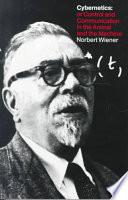Quotes from book
Cybernetics: Or Control and Communication in the Animal and the Machine

Cybernetics: Or Control and Communication in the Animal and the Machine is a book written by Norbert Wiener and published in 1948. It is the first public usage of the term "cybernetics" to refer to self-regulating mechanisms. The book laid the theoretical foundation for servomechanisms , automatic navigation, analog computing, artificial intelligence, neuroscience, and reliable communications.

“onlyinclude>|Information is information|”
V. Computing Machines and the Nervous System. p. 132.
Cybernetics: Or Control and Communication in the Animal and the Machine (1948)